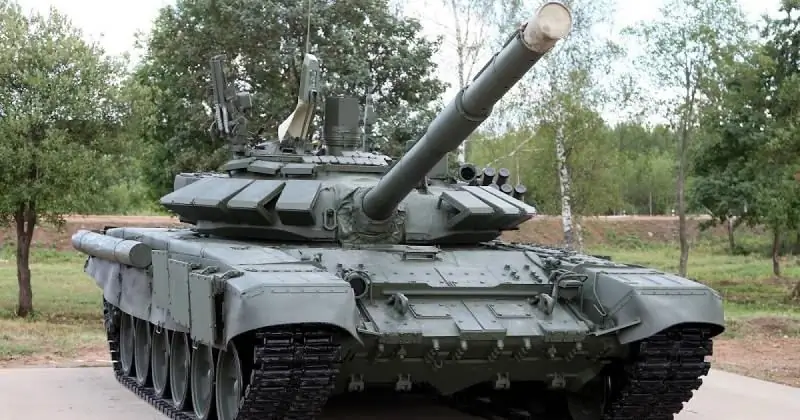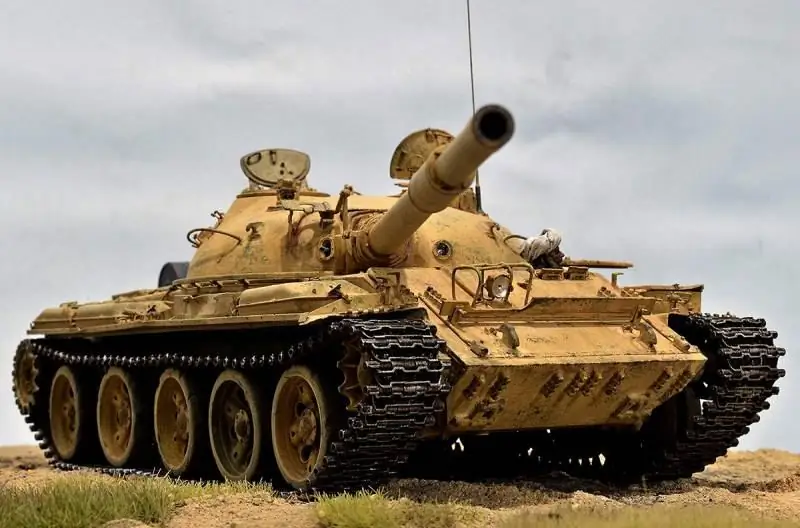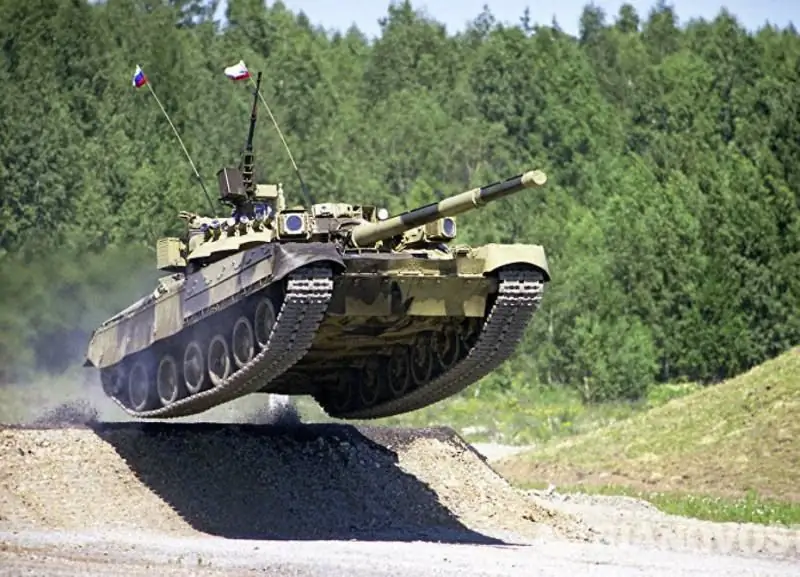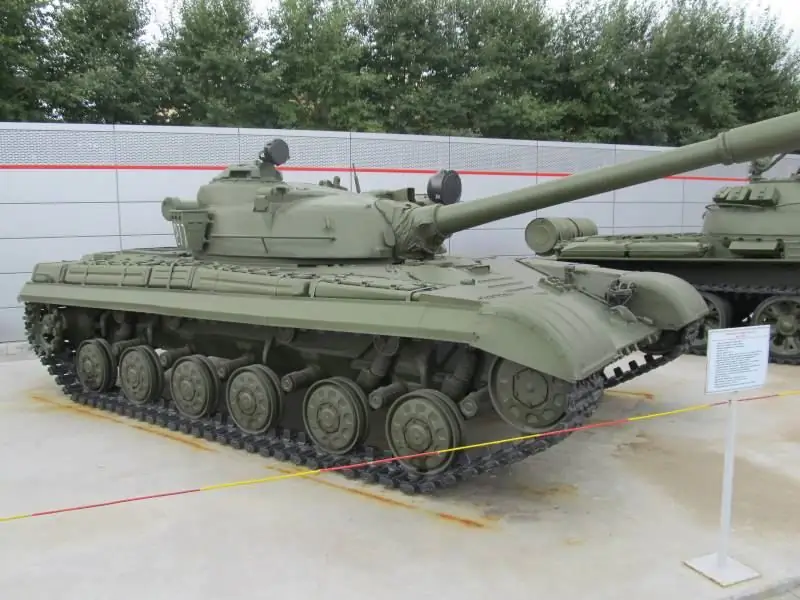- Author Matthew Elmers [email protected].
- Public 2023-12-16 21:49.
- Last modified 2025-01-24 09:17.

“I have served and operated both of these machines and I will say that it is not so. The T-62 was a dead end in development, and it could not surpass the T-55 in any … specified indicator."
svp67 (Sergey)
The designers tell. It just so happened historically that at one time I was invited to edit one of the books by the authors of the Kirov plant about the tanks that they produced, and this gave me a lot of very interesting information. Then he was invited to join the editorial board of the journal Technics and Armaments. This position, of course, was purely nominal, for the list in the imprint of the journal, and as I wrote my articles there on a general basis, so I continued to write. However, there was also a preference - a free subscription to this magazine. And in it were published very interesting memoirs of our designers and aviation workers, and missilemen, and tankers. That is, people who cooked in the cauldron of their business in the most direct way. I was especially interested in the memoirs of L. N. Kartsev, chief designer and creator of the T-72 tank. There is a lot in them, and not always specific, and related to the topic, therefore, their very close literary retelling is presented to the attention of the readers of "VO". That is to say, information about what sometimes I, as the author of certain materials, rely on, making my own conclusions. My remarks and explanations are also present in the text. But how can we do without it: they are needed, what to show what conclusions can be reached by reading these memoirs.
Appreciated the brand of the plant
One of the problems of our Soviet national economy as a whole, and in particular factories (both military and those producing peaceful products) were the so-called bogies. Their motto was a significant phrase: "You are the owner, not a guest, take away at least a nail." However, Kartsev himself wrote about this somewhat differently. Periodically, an exhibition of "items" seized by his guards at the entrance was held at his plant. And here we came across homemade pistols, revolvers, knives, pistons with piston rings and many other homemade products; moreover, the pistols were the best in the field both in design and in the quality of their manufacture. Once from the factory they even tried to take out a sealed case for a motorcycle sidecar, made very carefully. In the workshop where he was bungled, a seven-ton hammer worked, riveting only one part - an axle for railway cars, and here on you - a carriage was made! And now the director of the plant appeals to the head of the shop under Kartsev and says that, they say, if I gave you an assignment to make such a wheelchair, then you would beg at least 50 designers, technologists in addition to the staff … "And here - one, two and you're done! And what does this mean? Yes, only that in Soviet times one's shirt was closest to the body, and that it was possible to work for oneself much more efficiently than for society.
By the way, Kartsev writes that the directors of the plant were constantly asked: why does he take the risk of introducing new machines? To this he replied that, firstly, he values the brand of the plant, wants to be ahead of Kharkov in terms of tanks, and besides, otherwise he will not be able to economically keep the plant afloat.
“Okunev’s last phrase requires clarification,” Kartsev wrote further and explained it in such a way that until 1965 the Stalinist management system operated in industry, worked clearly and gave positive results.“Then, annually in February, the directive order of the production rate was tightened by 15%. If for the manufacture of some part they paid, for example, one ruble, then from March 1 it was already 85 kopecks, and next year 72 kopecks, etc. One of his colleagues joked about the next cut in prices: “I have been working at the plant for many years, the norms are tightened every year, now the plant has to pay extra for tanks, and not receive money”.
Therefore, in order to receive profit by the plant, they tried to reduce the labor intensity of production, introducing more and more productive equipment or completely "in the Soviet way" putting extra "fat" into the norms, so that later there would be something to tighten. However, this is not right. In fact, this very "fat" is nothing but a direct deception of their own state of workers and peasants, the Soviet people and "general justice." And what did such a policy of postscripting lead to? L. Kartsev gives such an example: "the labor intensity of manufacturing the T-55 and T-62 tanks was practically the same, and due to the improvement of the combat characteristics of the latter, the price for it was 15% higher than for the T-55 tank." But this is so wrong! The weapons manufacturing plant should proceed from the actual labor costs, and not which product is "better" and which is "worse". Moreover, the approach of lowering prices for the purpose of introducing new technology is also wrong. We need a scientific calculation of increasing labor productivity on the basis of the introduction of new technology, for this calculation - a plan, since it was planning that was the basis of our society, under the plan - new equipment. And after their application would have yielded results, it would have been possible to lower the prices, since this would not have affected the wages of the workers. This is the only possible approach in a socially oriented state.
It is interesting that L. Kartsev liked the introduction of economic councils, and here's why.
"With the introduction of these new regional governance structures, we immediately felt a big difference from the former ministries, where arrogance, arrogance and red tape flourished." But the economic councils liked him for their accessibility. That is, somehow … "at home" they worked, without this very red tape and other things, that's even how. In the Sverdlovsk Economic Council, at first, there was no access control at all. And they introduced it for one "important reason": so that outsiders do not go to the dining room of the economic council."
Moreover, Kartsev himself, in his memoirs, repeatedly criticizes N. S. Khrushchev, but his brainchild, the economic councils, the chief designer of the tanks, as you can see, liked it.
According to Kartsev, the economic councils made it possible to create enterprises of various industries in one region. This has accelerated the exchange of best practices. As a result, it turned out that the factories of our Sverdlovsk Economic Council alone were able to manufacture and fully equip any tank … But the main thing, in his opinion, were new people, production specialists who came to them. And he writes that he experienced great disappointment when in 1965, after Khrushchev was dismissed, the economic councils were disbanded, and the structure of managing the national economy was revived from a single center.
And here is his opinion (as the chief designer) on the activities of the so-called head industry institutes. How three of them functioned, he knew especially well. They themselves were not directly involved in the development of design documentation for new machines before introducing them into production. Their main task, according to Kartsev, was quite different, namely, to please everyone in the branch ministry, right down to the very last official. And at the same time, any orders of local party bodies are unconditionally obeyed. The main thing was to find out "where the wind is blowing", and then to provide a "scientific" basis for any thought that the higher authorities expressed. But the worst thing was that they, like vacuum cleaners, pulled talented personnel out of the industry.
For example, such "wonderful, talented designers as I. Bushnev, N. Izosimov, Yu. Gancho, A. Skornyakov, I. Khovanov, S. Lorenzo, etc." In many, he then noticed dull eyes, while others simply began to drink too much out of boredom. That is, people who could benefit the state, having fallen into this "administrative swamp", stopped doing it, but … they received their salaries on a regular basis.
The "tankers" were bothered by our Soviet way of life. So, in the summer of 1969, two tanks "object 172" were taken from Nizhny Tagil to Central Asia. And, of course, knowing that there are refrigerators on sale there, which for some reason were absent in Nizhny Tagil, the plant workers gave the head of the echelon money to purchase them. We bought 65 refrigerators, covered them with tarpaulins and drove them away.
But it turned out that the commandant of one of the stations, examining the train, looked under the tarpaulin, saw these refrigerators and immediately called the OBKHSS. As a result, the train arriving from Central Asia with tanks was not allowed to enter the plant, they were kept “under arrest”, and the employees who donated money for refrigerators were summoned for a month and a half for interrogations “where necessary”. No crime was found, but they made people nervous and delayed work on the tanks.
I never bowed before anyone
In the process of creating new tanks, things were constantly happening, not just curious, but even such that it is impossible to give a decent definition of them. Kartsev was appointed chairman of the commission for the acceptance of the layout of the new model of the tank of the Kirov plant. One of the comments was this: the size of the roof of the tower does not allow to put the hatches for the crew, as expected, that is, with its axis across the tower. The Kirovites, however, found a way out: they set them up, turning them 90 degrees. It is clear, it seems, not even a professional, that this is inconvenient. You don't have to be an engineer to notice and understand this. And one more thing - military affairs do not tolerate inconvenience. But … but!
When Kartsev pointed out this, the chief designer of Kirovsky replied that the size of the hatch exactly corresponds to GOST. Kartsev had to ask: "Nikolai Sergeevich, is the door in your office made according to GOST?" He, of course, answered: "Yes." It was then that Kartsev suggested that he turn the door 90 degrees, and go out through it … The model was not approved in the end. But this was obvious from the very beginning. And it was not done by yesterday's schoolchildren!
It is even more interesting further. In 1974, the General Staff ordered R&D from Nizhny Tagil to determine the combat effectiveness of tanks. Moreover, the T-55 tank was taken as a sample, the efficiency coefficient of which was taken as a unit. Two branch research institutes and the Military Academy of Armored Forces took part in this work. Sorted out with the coefficients for two years. Moreover, Kartsev, although he was the chief designer of the plant in Nizhny Tagil, at first did not participate in this work, since he did not see productivity in it. All the same, nothing changed in the tanks.
Finally, the General Staff demanded a summary table of this "important work." To speed up the work, Kartsev suggested not counting hundredths, but stopping at tenths. And what turned out to be? The coefficient for the T-62 tank became 1, 1, and the same was for all the others. Then Kartsev, who was supposed to be responsible for this table, asked the audience if they knew how the Pope was chosen in the Vatican? Nobody knew, and then he said that he himself would go to dinner, and they would be locked up and released only when they agreed on all the points. Needless to say, everything was agreed upon while the chief was having lunch. True, it remained to determine the coefficients for a promising tank.
And here Kartsev again came to the aid of the story: "" And he ordered: "" "". And with this proposal, everyone immediately agreed and immediately went to dinner. Because tanks are tanks, and you want to eat right now. An hour later, the table was already printed. Everyone signed it. And Kartsev went to Babajanyan, who immediately approved her. This is how the two-year work was completed on just one particularly meaningless piece of paper!
The story of the tanks from Syria is no less revealing. It was in the winter of 1978. A complaint came from Syria about poorly performed repairs of tanks that were being repaired at our repair factories. As always, a group of specialists was immediately assembled and sent to investigate. Kartsev arrived as part of a group to Kiev, where these tanks were being repaired, and saw that the workers were diligently repairing the heater, but some of the pipes at the radiator were muffled.

A friend of Kartsev worked at the enterprise, and when he expressed his comments to him, he explained that everything was done according to the instructions.
“I asked him to give me this instruction. It was done incorrectly: the "allowed" column lists parts and assemblies of inferior quality than in the main one, although according to the rules everything should be the other way around. I read the line "radiator": in the main column - 1st category, in the column "allowed" - 2nd category. And so on all the details and nodes. If you assemble a tank from parts according to the "allowed" column, it will not budge at all. " As a result, Kartsev asked his comrade to redo everything "out of friendship," and after returning from a business trip, he wrote in a report that the poor-quality repair of tanks supplied to Syria was to blame … the instructions issued by the head of the tank forces' department.
Needless to say, there was no reaction to this paper of his? After all, the boss cannot be wrong.
To one of the military representatives, who delayed the travel dates of several engineers, simply not putting a signature on the required report in time, Kartsev said: "!" And it is clear that he signed everything at once. But … he immediately concocted a letter to the Central Committee of the CPSU, in which he accused Kartsev of statements that defamed NS. Khrushchev, R. Ya. Malinovsky and some other leaders of the country. And besides, before he was sent, he demanded to consider it at a meeting of the plant's party committee.
In general, everyone himself, to the best of his imagination, can imagine what exactly was written there and read out at this meeting. The floor was given to Kartsev, and he answered so bluntly that he did not agree with the technical line in tank building, which is currently supported by the apparatus of the Central Committee of the CPSU. But he does not care about the personality of both Khrushchev and Malinovsky, their lives, characters, and behavior. Then they gave the floor to this military representative and he began to read out: "". Well, then everything is like that.
It's good that one of the members of the party committee was found here and said that everyone knows Kartseva, that he is a direct and principled person, a patriot of both the plant and our country. But who is this … How much did he save up these records? In general, everything ended well, but when Kartsev left that meeting of the party committee, he, as he himself writes, was simply thrown into a cold sweat. What if all this had happened in 1937? This is how honest people, loyal to the Soviet regime, then perished on denunciations of such people!
It's funny that, according to Kartsev, it was the designers and technologists who were the most disadvantaged people in production at that time. So, for 16 years in the position of chief designer, he never received a single bonus for the constant implementation of quarterly plans for the release of new equipment, not to mention the fact that these plans were constantly overfulfilled by the plant. And for a long time he did not even realize that there were these awards and that the management of his enterprise received them regularly. In addition, the T-54, T-55, T-62 tanks were produced under licenses in many other countries, in addition, they were sold abroad. But none of the designers received a single penny in reward for this. But we were talking about millions of dollars and rubles received by the state, and from all this wealth it was possible to unfasten at least a couple of percent to its creators ?!
Kartsev also spoke extremely negatively about the story that took place with the T-80 tank, when in mid-1976 the chief designer of the Kirov plant in Leningrad and a member of the Central Committee of the CPSU, N. S. Popov managed to convince the military and political leaders of the USSR that it is extremely important for us to adopt the T-80. Meanwhile, if we compare it with the T-64A and T-72 tanks we already have, it turns out that it had the same armament with them, similar indicators in terms of security and maneuverability, but it is much larger (i.e. approximately 1, 6-1, 8 times) consumed fuel per kilometer, and, although its reserve on the tank was significantly increased, its cruising range itself was reduced by 25-30%.
In addition, the T-80 used a fighting compartment taken from the T-64A tank. And it used vertical stacking of shots, which in combat conditions, according to Kartsev, reduced the survivability of the tank. Another drawback was the impossibility of direct communication between the tankers in the tower and the driver, and especially his evacuation when injured. In general, this tank was more complex, cost more and was less reliable than the same T-64A, not to mention the T-72.

The production of the T-80 was started not in Leningrad, but at the Omsk plant, where the T-55 was previously produced. Meanwhile, according to Popov, another new tank will be ready in Kharkov. “These“miracles”, - writes Kartsev, - were promoted in the first place by D. F. Ustinov, Deputy Chairman of the Council of Ministers of the USSR L. V. Smirnov, head of the industrial department of the Central Committee of the CPSU I. F. Dmitriev and other high-ranking officials, with L. I. Brezhnev.
In addition to the words of Kartsev, one can add only the following that hardly all these people were "spies" and "traitors", "anti-Sovietists and Russophobes." They just … they saw it that way, believed that it would be better for the country, and for the system, and for themselves. And they did not see anything wrong with that! This became clear only later, but so far that they were mistaken, undoubtedly many saw, but they, including Kartsev himself, could do absolutely nothing.
As for the Kharkov T-64A tank ("object 430"), then, according to Kartsev, this conceptual idea ultimately led to the fact that this vehicle had no development prospects at all. And the engine, and the chassis, and all of its other components and mechanisms did not have the proper margin of safety and worked at the limit of their capabilities. Due to the peculiarities of the packing of shots, the crew also had a hard time in it.

It was not so with the T-72, which had only one gun identical to the T-64A. Adopted on August 7, 1973, it was primarily designed for mass production at existing factories and equipment in use. The crew's living conditions have been improved. Significant reserves for modernization were laid in the tank, as well as the possibility of creating special-purpose vehicles on its basis. Well, the fact that all this is exactly so, and not the designer's praise to his own brainchild, confirms the experience of operating the T-72 in various countries of the world and the fact that it was the most massive tank of the second half of the 20th century.
Kartsev's opinion about the reasons that caused 1991 is also interesting, although, of course, he considers them from his familiar side. In his opinion, taking advantage of the fact that our tanks were relatively simple and cheap, "a".
“The country has found itself in a dead end, has got into colossal debts. The leaders of the state sometimes acted like Ellochka the cannibal from the novel by Ilf and Petrov, The Twelve Chairs, who tried to copy the daughter of an American billionaire."
Well, then, judging by the fate of this chief designer, the "people at the top" simply did not forgive him for his talent, conviction, and … the correctness of his views. When the T-72 "went", the "Moor" was no longer needed, and he was transferred to one of those industrial research institutes, whose activities he did not like so much. Apparently, he did not always speak disagreeably about those whom he considered … "not too smart" people. Well, big bosses, especially in uniform, do not like this. But this part of his memoirs is especially revealing:
“I see satisfaction with my life only in the fact that I have never bowed down to anyone and did not curry favor with anyone in power, did not do anything against my conscience. Never putting up with humiliation of myself, I, being invested with administrative power over people, tried to do everything possible so as not to offend their human dignity in any way."
Wonderful words, aren't they?
Instead of an epilogue
And now, as a kind of epilogue to the final paragraph of our story about man and tanks, an example from ancient history will be cited. It is also very indicative and interesting in its own way.
… The great Pericles dies. The best citizens of Athens, his friends, gathered around him and began to decide how to honor his memory and what to write on his tombstone. One said that he put nine trophies in honor of his military victories, that is, he was a worthy commander; others - that he erected the Parthenon and Propylaea, others noted his high moral qualities and the authority of a politician. And then Pericles, about whom they thought he was unconscious, opens his eyes and says that all this, of course, is correct, but you, worthy men of Athens, have forgotten about the most important thing! One can imagine their embarrassment, because they thought that he did not hear them. Finally, one of those present made up his mind and asked: “O glorious Pericles, tell me what you yourself consider your main merit to your fatherland. We've gone through everything!"
And Pericles answered in a way that few politicians, both past and present, could answer this question. And he said: "Being in power in Athens for 14 years and possessing all its fullness, I ruled so wisely and carefully that not a single Athenian can say that it was my fault that he put on the black cloak of grief!" And all those gathered decided that yes, all his other merits pale before this. And we agreed with him!
References
Kartsev L. N. Memories of the chief designer of tanks. - Equipment and weapons. - 2008. Nos. 1-5, 8, 9, 11.






